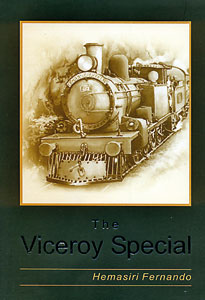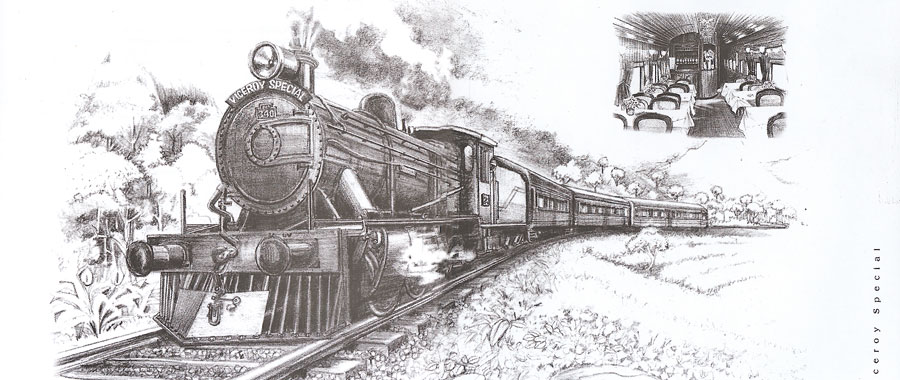Railway enthusiast and a ‘results oriented man’
View(s):Book facts | The Viceroy Special by Hemasiri Fernando. Reviewed by A. D. V. de S. Indraratna
When Hemasiri Fernando (henceforth Hemasiri as I call him) handed me a copy of “The Viceroy Special” authored by him with a request for a review, I undertook it with immeasurable pleasure. For I hold Hemasiri, one of my old students in great affection and high esteem.

I had another reason: I was a railway employee as an Assistant Transportation Superintendent for six months after my graduation before I joined the (then) University of Ceylon. Nonetheless, I was at the same time slightly taken aback. I came to know Hemasiri closely as the Lecturer-in-Charge of the Department of Economics of the University of Ceylon, in the early sixties;
This was in his capacity as a good student of Economics as well as a good athlete and sportsman; I was also aware that he was engaged in student politics as well. However, I had never witnessed (this might have been true of my colleagues as well) any evidence of his ‘steam enthusiasm’ at that time, even though in his book he states that he had developed a fascination for steam locomotives from the young age of four, and “had graduated as a fully fledged steam enthusiast” by the time he entered University in 1963, and thereafter “had the railway enthusiasm as (his) first hobby”
(Chapter 2).
Hemasiri commences his book with an Introduction of the history of the Ceylon Railway. It begins in 1942, 12 years after the railway was first introduced in Britain, when the necessity for it was identified by our then colonial masters for the coffee plantations; It runs through with the formation of the Railway Company in 1945, building the first railway line from Colombo to Kandy and to the completion of a total length of 1453 km of railway covering all nine provinces of the country by 1925, with operation of the steam locomotive, and the full dieselisation by 1969. This Introduction ends with a reference to the “Viceroy Special”, locomotive engine luxury train, which has been in operation since 1986.
Among several books on the history of Ceylon’s railway that have been written, (see his Reference list) this succinct introductory narrative of Hemasiri, I have no doubt, ranks as one which gives a complete and clear history of Sri Lanka’s (then Ceylon’s) Railways.
According to my reading of the book, “The Viceroy Special”, its title, though a concept of Cliff Jones, his British friend, is the entire make of Hemasiri. This is amply corroborated by P.P. Wijesekera, the former General Manager, Sri Lanka Railways, and Tilak Collure, former Secretary, Ministry of Transport, in the conclusions of their respective forewords to the book: “For me the most admirable part of the whole episode is the skills demonstrated by the author in navigating such a huge project in the turbulent waters of bureaucratic governmental set-up”; “The history of one man’s labour of love has provided a legacy in the form of the ‘Viceroy’ steam train for every one to marvel and relive the glorious heyday of steam train travel.”

Artist’s impression of the Viceroy Special and inset, its refurbished carriages
Hemasiri follows his introduction with his own preface to the book where with his characteristic enthusiasm and commitment for anything which he undertakes, he describes vividly and lucidly how he has developed his interest for steam/rail from his childhood up to the present and how this enthusiasm has grown as a life hobby, alongside the growth of the Sri Lankan Railway, and how he was able to accomplish the inauguration of the “Viceroy Special” in 1986, feeling rightly elated thereon as “a fully pledged Railway Enthusiast.”
The accomplishment of this project of the Viceroy Special, almost an impossible task in the view of many, is dramatically described in the remainder of the book comprising 26 short chapters. I will not make a chapter by chapter review of it, but highlight some of the things which impressed me most.
The story of the project begins with reference to the first meeting of Hemasiri with the Britisher Cliff Jones in February 1984, those most turbulent times of our country. It is Cliff Jones who had transmitted the concept of “the Viceroy Special” to Hemasiri.
Thereafter, it was sheer enthusiasm, courage, fearlessness, commitment and persuasiveness of this railway enthusiast, Hemasiri, which enabled the project to take off and see its completion. From the time it took off, there was no point of return for him; no barriers or obstacles or constraints that would dampen him; there was no problem beyond his solution or redemption. How he was able to convince the Chairman, Tourist Board, the General Manager Railways, the main stake-holders, of the viability of this project was remarkable. Equally amazing was how he was able to garner the support and cooperation of the relevant railway employees at every level despite the bureaucratic red tape and the slow motion often associated with the public servant.
The 26 chapters not only give a lucid, fascinating account of the inauguration of the Viceroy Special, on schedule, on February 2, 1986, 18 months from the time the project really took off, but also reflect the aforesaid characteristic attributes of Hemasiri, which enabled its accomplishment. Chapter VI on Enthusiasm Vs Feasibility, Chapter IX on A Results Oriented Man, Chapter XIV on Uncertainty and Sustainability and Chapter XVI on Motivating Workers may be of particular relevance in this regard. This is amply demonstrated by the following two extracts from Chapter XIV and XVI respectively of the author’s own words: “…….I have fallen in love with this project. I will leave no stone unturned to make it a reality, but I am not rich enough to support it financially. I got my wife to agree to sell my new car and raise part of the funds. I can use an old car from (my) company. This project is absolutely much more important than my personal comfort……….”; “Cliff Jones’ distraction from the project placed many responsibilities on my shoulders. …….I have made up my mind to succeed despite setbacks. My career was full of challenges and I had the determination to achieve most of my goals. Why not this one, I thought”.
This book is unique in a way: It not only gives an historical account of the development of a project, but also reveals the characteristic attributes of the navigator of the project. There is also an important lesson to learn from it: There may be hardly any project in which one cannot succeed if one has the qualities as displayed by the author of this book, such as the enthusiasm, sustainability of interest, persuasion and determination, ability to motivate and convince others both above and below. Its reading is so fascinating that I, normally a slow reader, did not want to put it aside for any other work, until I finished reading it.
This book should interest not only the railway enthusiast, but also the public servant. It should also find a place in every public library or library of higher education institute.
Follow @timesonlinelk
comments powered by Disqus


